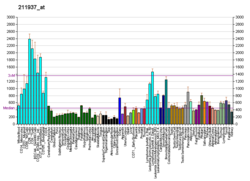Top Qs
Timeline
Chat
Perspective
EIF4B
Protein-coding gene in humans From Wikipedia, the free encyclopedia
Remove ads
Eukaryotic translation initiation factor 4B is a protein that in humans is encoded by the EIF4B gene.[5]
Remove ads
Structure
EIF4B is characterized by a single folded RNA recognition motif (RRM) near its N-terminus, which adopts a classical beta alpha beta beta alpha beta topology. This RRM is responsible for RNA binding but interacts with RNA relatively weakly on its own; high-affinity binding is facilitated by adjacent N- and C-terminal extensions. The majority of the EIF4B protein, encompassing roughly 400 amino acids downstream of the RRM, is intrinsically disordered and forms what is known as the intrinsically disordered region (IDR). This IDR does not adopt a stable three-dimensional structure but instead enables dynamic interactions, self-association, and the formation of large oligomers and biomolecular condensates under certain cellular conditions. A short helical segment within the IDR, coinciding with an arginine-rich motif (ARM), further contributes to RNA binding.[6][7]
Mammalian eIF4B acts as a dimer, and other studies had shown that it could form higher-order oligomers as well, through intrinsically disordered regions (IDR).[7]
Remove ads
Function
Summarize
Perspective
Eukaryotic translation initiation factor 4B (EIF4B) is a multidomain protein essential for efficient cap-dependent translation in eukaryotic cells. Structurally, EIF4B contains a single folded RNA recognition motif (RRM) near its N-terminus.[6][8][9] This RRM is responsible for RNA binding but interacts with RNA relatively weakly on its own; high-affinity binding is facilitated by adjacent N- and C-terminal extensions.[6][10] The majority of the EIF4B protein, encompassing roughly 400 amino acids downstream of the RRM, is intrinsically disordered and forms what is known as the intrinsically disordered region (IDR).[7] This IDR does not adopt a stable three-dimensional structure but instead enables dynamic interactions, self-association, and the formation of large oligomers and biomolecular condensates under certain cellular conditions.[7] A short helical segment within the IDR, coinciding with an arginine-rich motif (ARM), further contributes to RNA binding.[7] The flexible and highly dynamic nature of the IDR allows EIF4B to orchestrate diverse molecular interactions critical for translation initiation, including stimulation of the helicase activity of eIF4A and supporting the assembly of other components of the translation initiation machinery.[11]
EIF4B is a critical protein in the process of cap-dependent translation initiation in eukaryotic cells. Its primary function is to enhance the helicase activity of eIF4A, a DEAD-box RNA helicase, by stimulating its ability to unwind secondary structures in the 5′ untranslated regions (UTRs) of mRNAs[9].[11][12] This unwinding activity is vital for the ribosome to scan along the mRNA and locate the start codon efficiently. eIF4B also acts as a scaffold by interacting with other translation initiation factors, such as eIF3 and eIF4F, facilitating the assembly of the translation initiation complex.[13] Furthermore, eIF4B’s RNA binding capacity—mediated both by its RNA recognition motif (RRM) and its arginine-rich motif (ARM)—directly supports the recruitment and stabilization of mRNA on the ribosome, ensuring efficient and accurate initiation of protein synthesis.[6][10] The multifaceted functions of eIF4B are essential for regulating translational output and adapting protein synthesis to cellular conditions.[14]
eIF4B has been shown to interact with and stimulate the enzymatic/RNA helicase activity of eIF4A, also increasing its RNA and ATP binding activity, and bind to the eIF3 complex through the eIF3A subunit.[15] This interaction results in the recruitment of the eukaryotic small ribosomal subunit (40S) to the mRNA which will in turn set the stage for the later steps leading to elongation.
Remove ads
Clinical significance
eIF4B is overexpressed in cancer cells and certain studies had named eIF4B as a potential therapeutic target for treatment of certain types of cancer.[16]
See also
References
Further reading
Wikiwand - on
Seamless Wikipedia browsing. On steroids.
Remove ads







